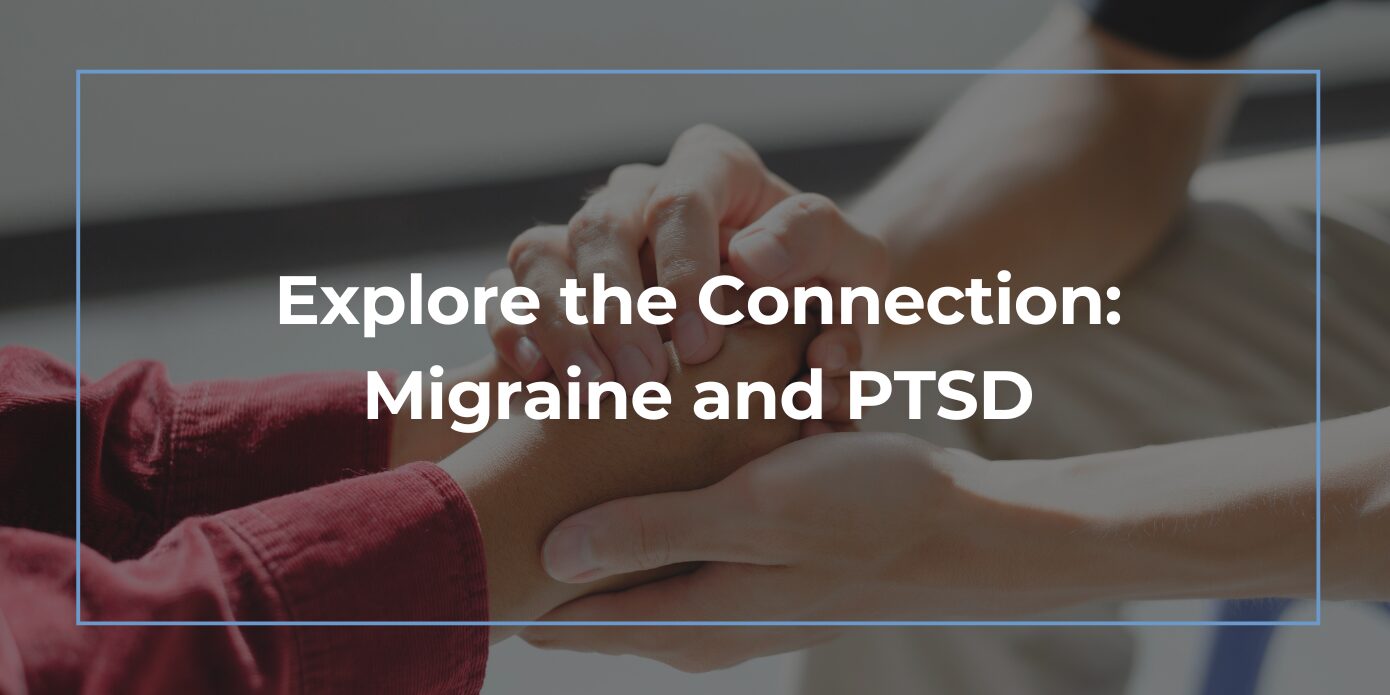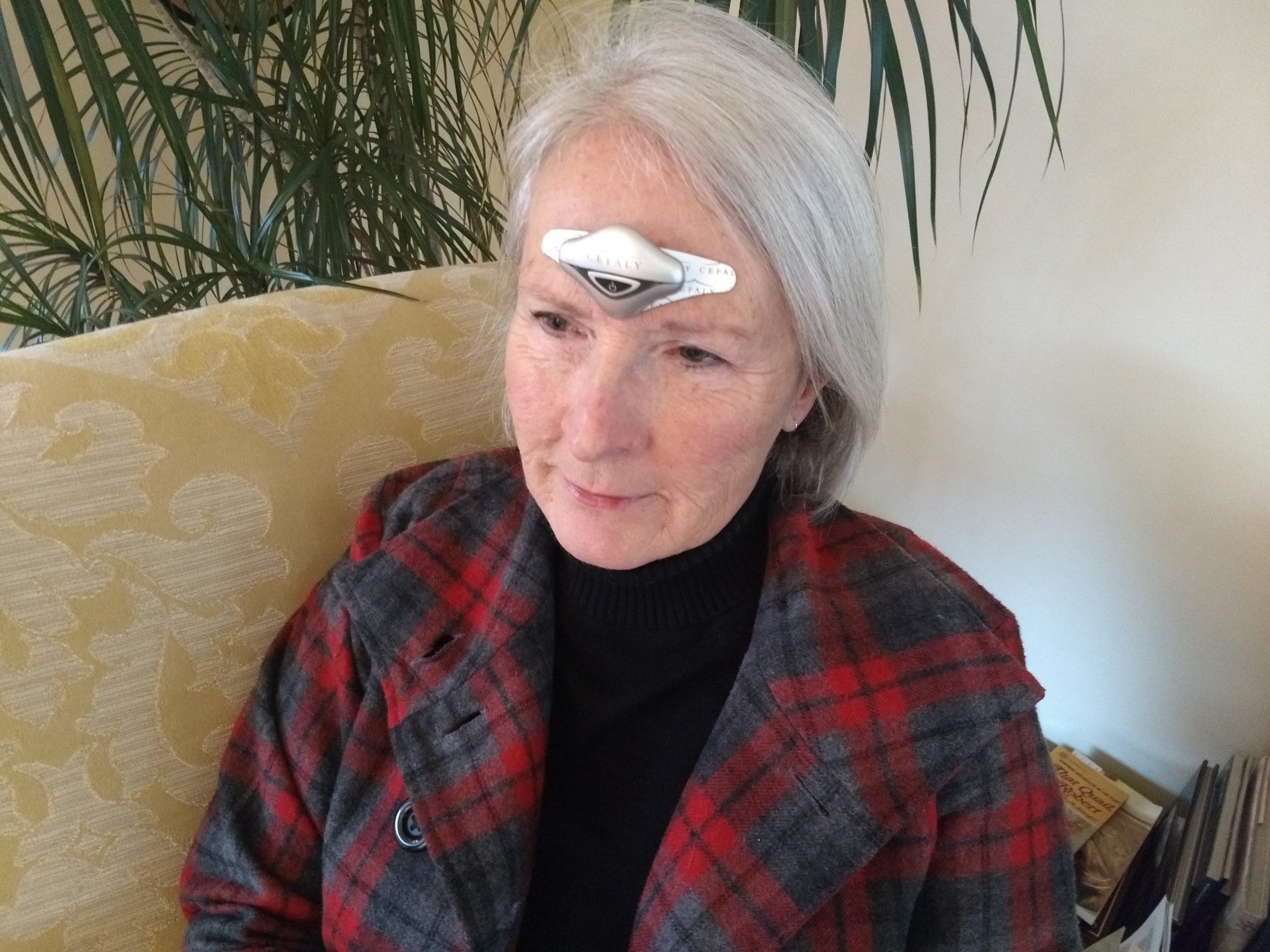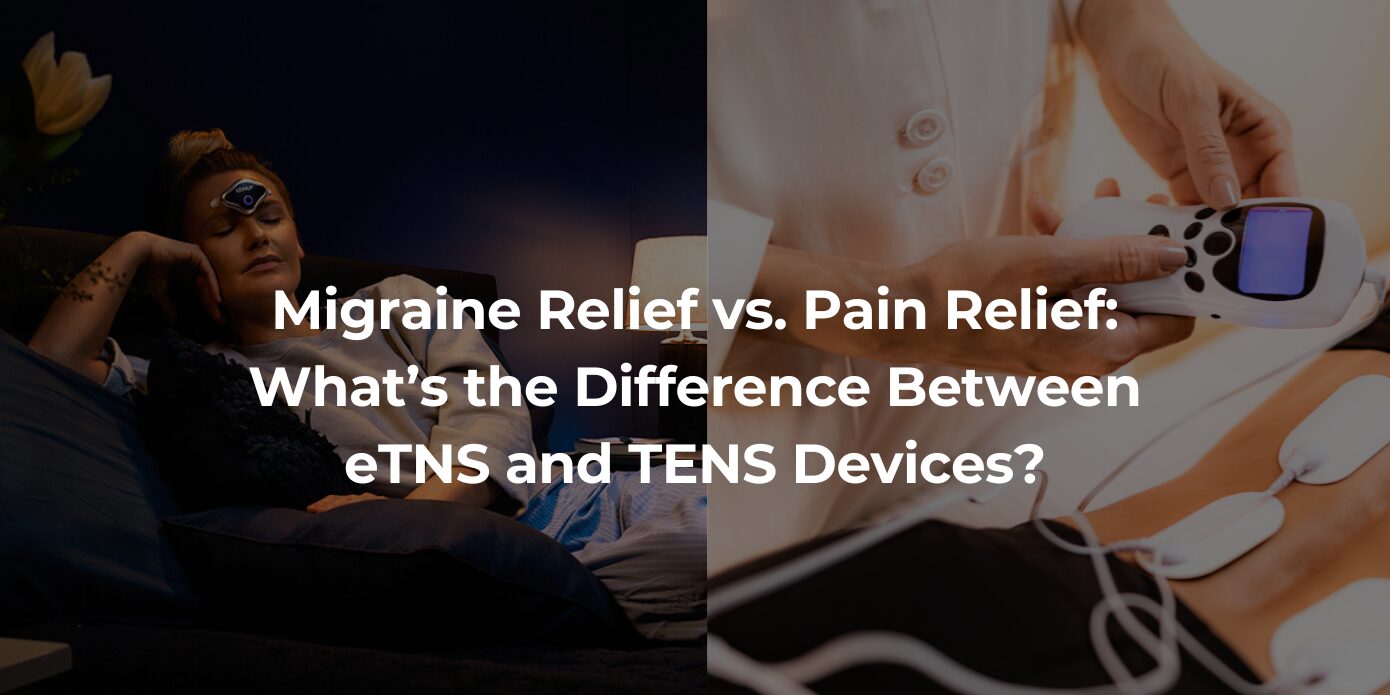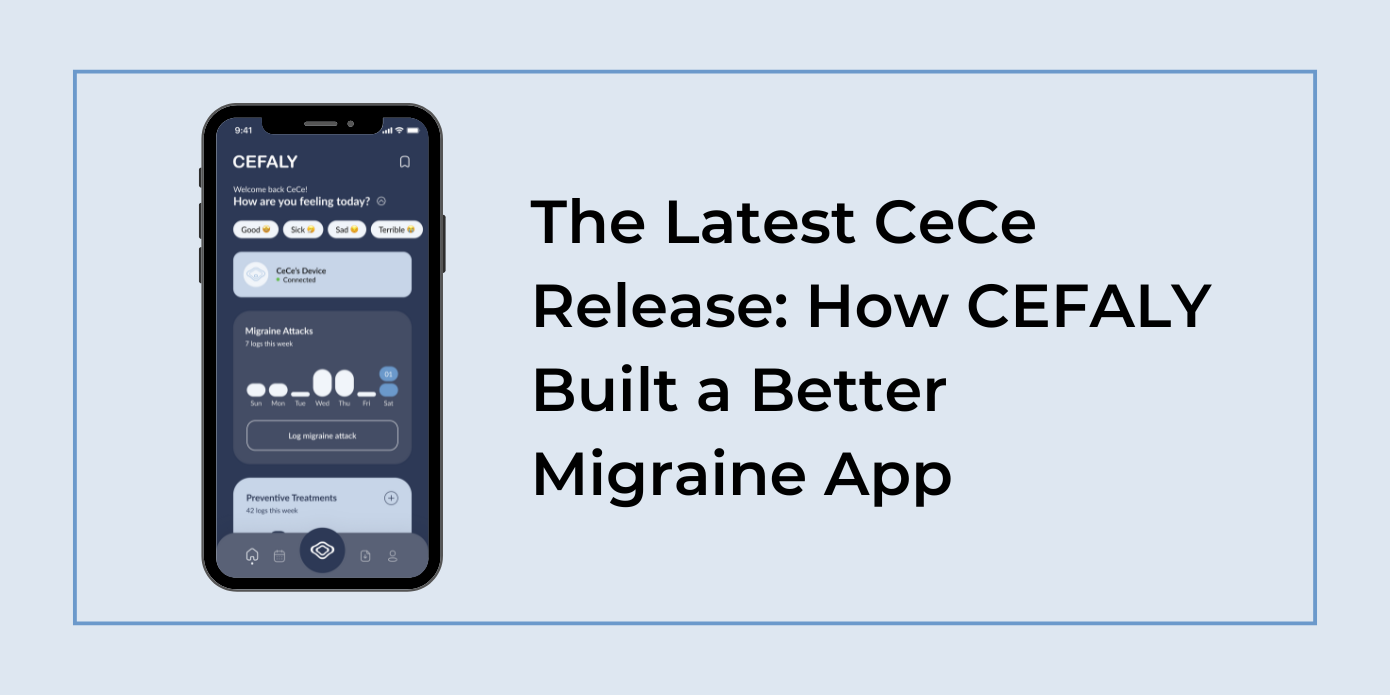- What is PTSD
- Relationship between PTSD and migraine
- Why are PTSD and migraine linked?
- Treatment approaches for migraine and PTSD
On the surface, migraine and PTSD don’t seem to have much in common.
Migraine is a neurological condition. PTSD (Post-Traumatic Stress Disorder) is a psychiatric condition. Migraine has a strong genetic component. PTSD is brought on by external trauma.
These two debilitating conditions are linked in some surprising ways, however — and having both can severely impact your quality of life. Don’t lose hope! There are treatments available that can help you feel better.
What is PTSD?
PTSD is a mental health condition that’s triggered by experiencing or witnessing a traumatic event (TLE). It’s natural to feel stressed or afraid when you believe you are in danger. This reaction is part of your body’s instinctive fight, flight or freeze response to threats.
Everyone reacts differently to a shocking or frightening experience, and most people recover from their initial symptoms. Those who continue having repercussions that affect their daily lives, long after a traumatic event, likely have PTSD.
According to the National Institute of Mental Health, people with PTSD may experience the following symptoms.
- Reliving: Flashbacks, recurring memories, distressing thoughts or physical signs of stress.
- Avoidance: Avoiding specific places, objects, routines or thoughts related to the traumatic event.
- Arousal and reactivity: You may startle easily or feel irritable and edgy, even in familiar surroundings. Other symptoms include difficulty concentrating or sleeping.
- Cognition and mood changes: These include social isolation, ongoing negative emotions or disinterest in previously enjoyable activities. Forgetfulness and poor decision-making may be other consequences.
These symptoms can persist for months or even years after the initial trauma, disrupting daily life and mental well-being.
That’s the official definition… but what does PTSD look like in real life? In popular culture, people with PTSD are often veterans who have experienced the trauma of war. While PTSD is often seen in military service members, PTSD can be triggered by any traumatic or intensely stressful event, such as a car crash, being the victim of a crime, or a natural disaster. The most common cause of PTSD is interpersonal trauma, such as sexual abuse or domestic violence.
People of all ages and walks of life can experience PTSD. However, not everyone who goes through something traumatic will go on to have this condition. Some may be more prone to develop the disorder based on their gender or occupation. For example, the National Center for PTSD states that women are more likely to develop PTSD than men. PTSD rates are also higher in the veteran population compared to civilians. About 7% of veterans will have PTSD at some point in their lives.
People experience PTSD differently. For some, PTSD begins right after the event. For others, years may pass before they experience it. PTSD can be triggered by a specific sensory experience, like a loud sound, a news report, or even a smell. Or, it may present as an ongoing hypervigilance or fear.
Do you have PTSD? This online screening tool can help you understand if you meet the criteria. See your healthcare provider for a formal diagnosis.
What’s the relationship between PTSD and migraine?
Migraine is a neurological disorder that usually involves intense headaches, along with nausea, vomiting, and sensitivity to light and sound. Lasting anywhere from a few hours to several days, a migraine attack can significantly impair your ability to function.
So what does post-traumatic stress disorder have to do with migraine? PTSD is much more common in people living with migraine. Research has shown that 21.5% of migraineurs will experience PTSD at some point in their lives, compared to just 4.5% of people without headache disorders. That’s a huge difference. Also, having PTSD can make migraine more disabling.
We also know that trauma and migraine are closely linked. One team of researchers analyzed the results of 28 different studies, which together included more than 150,000 participants. Their analysis found that experiencing at least one traumatic event in childhood increased the risk of a headache disorder in adulthood by 48%. For people who experienced multiple traumatic events, the risk went up even more.
PTSD-related stress and anxiety can be triggers for migraine attacks. The emotional strain of dealing with PTSD can make these migraine attacks more likely to happen. Plus, people with PTSD often become extra sensitive to pain, which can make migraine worse.
Other PTSD-related symptoms play a role. The chemical and hormonal imbalances in the body may also trigger migraine episodes. For example, there is a connection between migraine and mental health.
Moving away from the symptoms, the type of TLE experienced may also increase the likelihood. If someone with PTSD experienced a head injury during their TLE, they’re more likely to get migraine afterward because head injuries can impact neurological pathways.
We also know military veterans are much more likely to have migraine attacks triggered by the stress and injuries experienced during their service. Studies have shown that post-9/11 combat veterans are more likely to experience chronic migraine.
Understanding this link is essential for helping people get the proper treatment and support, especially for veterans who may have faced challenging situations during their service.
Get Drug-Free Migraine Relief With CEFALY
Shop Now
90-day money back guarantee
FDA-cleared
financing available
Prevalence and impact of PTSD and migraine
The overlap of PTSD and migraine is more common than you might think. According to the American Migraine Foundation, about 25% of people with migraine also have PTSD.
Living with PTSD and migraine can impact your quality of life. People facing this dual challenge may experience migraine disability and reduced well-being. The combination of PTSD and migraine can make daily tasks more challenging to manage, adversely affecting your career, relationships, health and life.
Managing both conditions can be challenging. PTSD symptoms like intrusive thoughts, hyperarousal and avoidance behaviors may exacerbate migraine. Conversely, the pain of migraine can trigger or worsen PTSD symptoms, creating a cycle of distress for those living with this dual diagnosis.
Unfortunately, finding relief for complex PTSD and migraine is not easy. Addressing both conditions requires a thorough approach informed by the interplay between psychological and physical symptoms. However, there are not many viable treatment options targeting this dual diagnosis, leaving people struggling to find remedies.
Why are PTSD and migraine linked?
Scientists are still trying to answer this question, but here are a few PTSD-migraine connections they have discovered so far.
- 1. Shared genes and biological pathways: Both PTSD and migraine involve changes in brain chemistry and function. Stress hormones like cortisol can trigger both PTSD symptoms and migraine attacks, indicating a shared underlying biological mechanism.
- 2. Stress and hyperarousal: Individuals with PTSD often experience heightened stress, which is a significant migraine trigger. The constant state of alertness and anxiety can lead to increased muscle tension and vascular changes in the brain, sparking migraine attacks.
- 3. Sleep disturbances: Both PTSD and migraine often involve sleep disturbances. Insomnia or disrupted sleep patterns can make PTSD symptoms worse and trigger migraine attacks. Not getting enough sleep can lead to a vicious cycle, where each condition worsens the other.
- 4. Emotional and physical strain: The emotional burden of PTSD can lead to physical symptoms, including migraine attacks. The chronic stress and anxiety associated with PTSD can cause frequent headaches, which in turn, increase stress levels, creating a feedback loop of pain and psychological distress.
- 5. Traumatic experiences: People who experienced trauma — like combat veterans and survivors of abuse and accidents — may be more susceptible to developing PTSD and migraine.
- 6. Adverse childhood experiences: Childhood trauma, neglect or household dysfunction may result in PTSD and migraine later in life. These experiences may have long-lasting effects on mental and physical health.
- 7. Environmental factors: Environmental stressors — like chronic stress, exposure to triggering events or living in high-risk environments — may exacerbate the link between PTSD and migraine. These can contribute to the onset and severity of symptoms.
- 8. Psychological influences: Psychological factors like stress, anxiety and depression can influence the PTSD- migraine relationship. People with PTSD often experience heightened levels of stress and anxiety, which may trigger migraine or worsen existing symptoms.
Understanding these factors can help medical professionals and those living with this dual diagnosis. This information can help you develop a tailored treatment plan that addresses migraine and PTSD.
Many people get PTSD headaches, but not all PTSD headaches are migraine headaches. If you believe you have either condition, or both, you should see your healthcare provider to get a diagnosis.
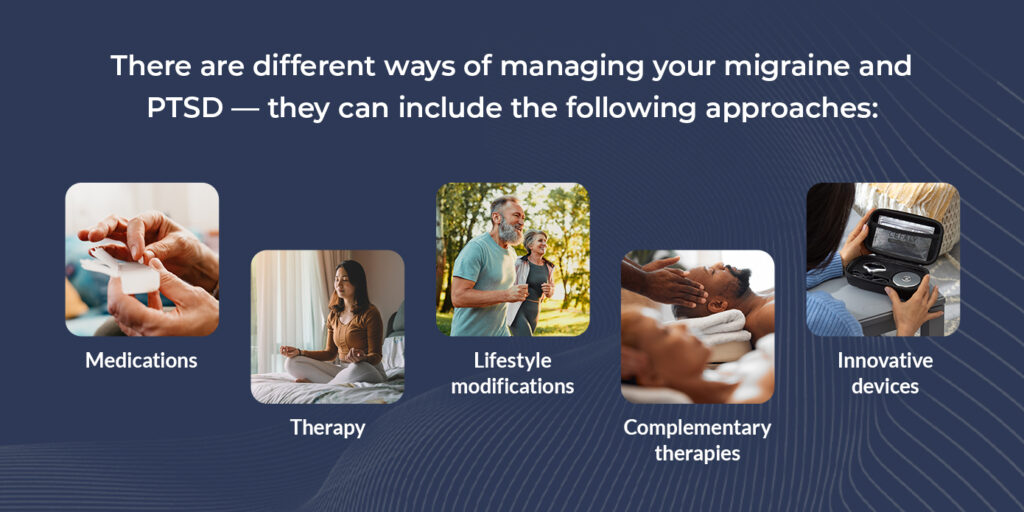
Treatment approaches for PTSD migraine
If you live with migraine and PTSD, take heart. There are treatments available that can address one or both conditions and improve your quality of life.
Therapeutic interventions
Methods like cognitive behavioral therapy can help you identify and change negative thought patterns and behaviors that contribute to PTSD and migraine symptoms. It can also teach you coping strategies for managing stress and anxiety, which are common triggers for migraine attacks.
- Cognitive Behavioral Therapy (CBT): Effective for treating both PTSD and migraines, CBT helps you gain control over negative thought patterns and behaviors that contribute to stress and pain.
- Exposure therapy: Gradually exposes individuals to trauma-related memories and situations in a controlled environment, reducing PTSD symptoms and associated migraine triggers.
Medications
Doctors can recommend or prescribe medications to manage migraine symptoms and prevent future attacks.
- Antidepressants and anti-anxiety medications: Certain antidepressants can help manage PTSD symptoms and also reduce the frequency of migraine attacks. These include amitriptyline and venlafaxine, which are both tricyclic antidepressants.
- Migraine-specific medications: Triptans and preventive medications can be prescribed to manage migraine attacks.
Lifestyle modifications
Making lifestyle changes can also help manage PTSD and migraine.Try practicing relaxation techniques, maintaining a regular sleep schedule, exercising regularly and avoiding known triggers for PTSD and/or migraine.
- Stress management: Techniques such as mindfulness, yoga, and meditation can help reduce overall stress levels, minimizing the occurrence of both PTSD symptoms and migraine attacks.
- Regular exercise: Physical activity can help alleviate stress and improve sleep quality, reducing the frequency and severity of migraine.
- Healthy diet and hydration: Avoiding migraine trigger foods and drinking plenty of water can help you feel better and manage both conditions.
- Sleep hygiene: Sticking to a regular sleep schedule can benefit both PTSD and migraine sufferers.
- Support systems: Engaging in support groups or therapy can provide a sense of community and understanding, offering relief from the isolation often felt by those with PTSD and chronic migraine.
Non-drug treatments
- Complementary and alternative therapies: Acupuncture, moxibustion, Chinese herbal medicines, and tai chi are all used to treat PTSD and migraine. These holistic remedies can enhance evidence-based therapeutic techniques like CBT.
- Neuromodulation: Stimulating the trigeminal nerve — a cranial nerve that’s the main pathway for migraine pain — with the non-invasive CEFALY device has been clinically proven to help prevent and relieve migraine pain. CEFALY does not treat PTSD, although researchers are examining other types of neuromodulation to see if it may be beneficial. Innovative technologies like CEFALY offer a promising option for managing migraine without medication. CEFALY Connected targets the trigeminal nerve with gentle electrical impulses. It’s a dual-purpose solution designed to relieve migraine attacks and prevent future episodes.
Manage Your Migraine With CEFALY
Trying to decrease your reliance on medication? CEFALY may be able to help! In one study, acute migraine medication intake decreased by 75% among patients who responded to PREVENT treatment with CEFALY. Overall, CEFALY users in the study saw an average 30% reduction in migraine days after 3 months of using the PREVENT treatment mode.
If you’re tired of battling PTSD plus migraine and seeking relief, CEFALY can be your drug-free solution — as it’s been for other users. Don’t let migraine attacks hold you back any longer. Buy your CEFALY Connected today and experience the difference for yourself.
Start your 90-day in-home trial — buy CEFALY today!
If you’re a U.S. veteran, CEFALY can be covered 100% by VA healthcare benefits. Learn how veterans can get migraine relief with CEFALY.

